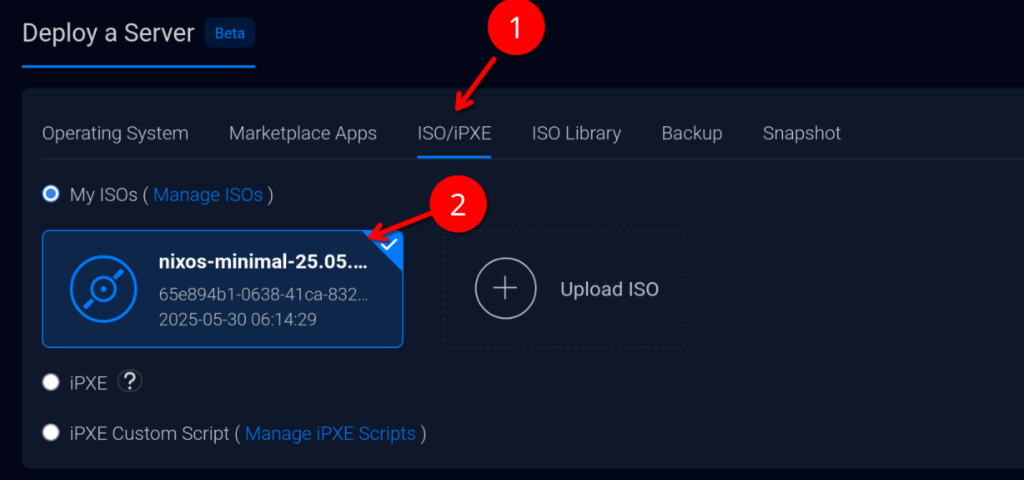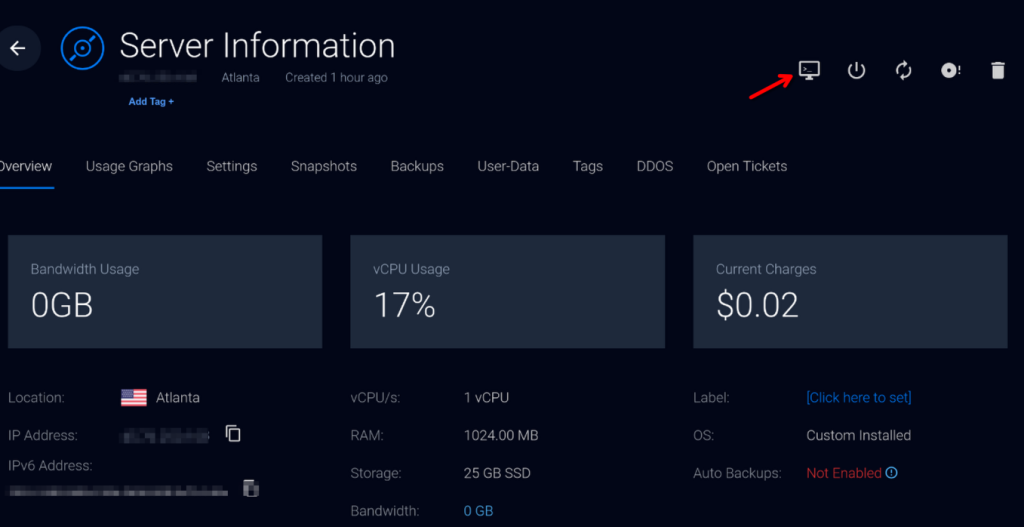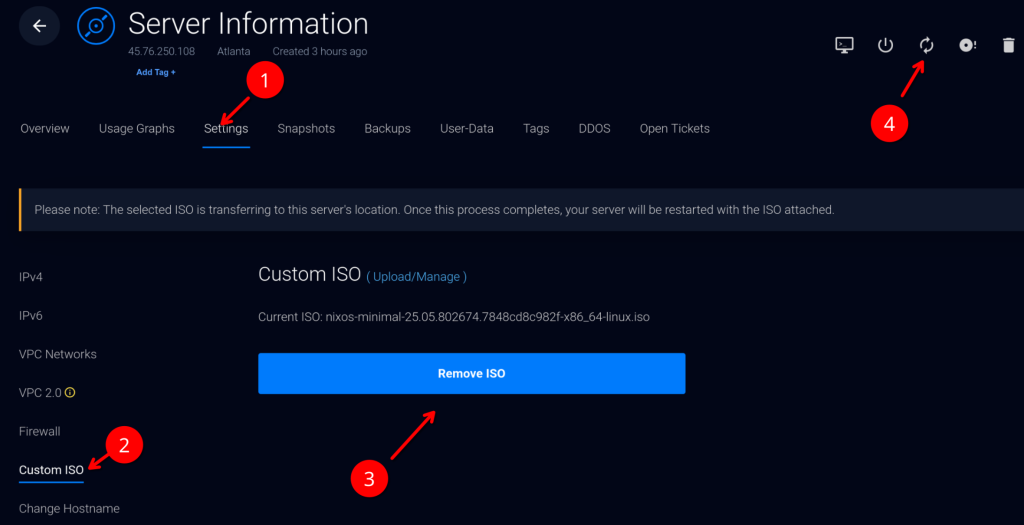Table of Contents
上传 ISO
从 NixOS官网 获取 最小化安装镜像(Minimal ISO image)的下载地址

在 Vultr 的上传页面,粘贴刚刚获取的地址,点击上传

Vultr 需要 5~10 分钟完成镜像下载,这个页面 可以看到下载进度,下载完成后有 MD5值供你验证完整性
使用自定义镜像部署服务器
部署的时候选择刚刚上传的 ISO 即可

SSH 连接
第一次需要通过WEB UI 上提供的终端来访问

设置密码(这只是 LiveCD 的密码,方便 SSH连接,重启后失效)
# set "nixos" password
passwd
# set "root" password
sudo passwd现在你可以从本地 SSH 客户端连接服务器了
分区
# login as root
sudo -i
# create a MBR partition table
parted /dev/vda -- mklabel msdos
# create root partition
parted /dev/vda -- mkpart primary 1MB -2GB
# Set the root partition’s boot flag to on. This allows the disk to be booted from.
parted /dev/vda -- set 1 boot on
# create swap partition
parted /dev/vda -- mkpart primary linux-swap -2GB 100%
# format
mkfs.ext4 -L nixos /dev/vda1
mkswap -L swap /dev/vda2
```⚠️ 记得用 lsblk -f 确认你的磁盘名
⚠️ 我尝试过 UEFI(GPT),Vultr 似乎不支持
安装
# mount root
mount /dev/disk/by-label/nixos /mnt
# enable swap now
swapon /dev/vda2
# generate an initial configuration file
nixos-generate-config --root /mnt --flake
# config your system
vim /mnt/etc/nixos/configuration.nix
# install
nixos-install --flake '/mnt/etc/nixos#server'
# As the last step, `nixos-install` will ask you to set the password for the `root` user, e.g.
# set password for other user
nixos-enter --root /mnt -c 'passwd glaumar'参考配置
nixos-generate-config 生成的配置文件不要直接用,特别是启动的磁盘路径( boot.loader.grub.device)一定不要错,下面提供一份基本的可起动配置做参考(configuration.nix),这个配置开启了 SSH服务(没开防火墙),并添加了一个名为 “glaumar”的用户
# Edit this configuration file to define what should be installed on
# your system. Help is available in the configuration.nix(5) man page, on
# https://search.nixos.org/options and in the NixOS manual (`nixos-help`).
{ config, lib, pkgs, ... }:
{
imports =
[ # Include the results of the hardware scan.
./hardware-configuration.nix
];
# Use the GRUB 2 boot loader.
boot.loader.grub.enable = true;
# boot.loader.grub.efiSupport = true;
# boot.loader.grub.efiInstallAsRemovable = true;
# boot.loader.efi.efiSysMountPoint = "/boot/efi";
# Define on which hard drive you want to install Grub.
boot.loader.grub.device = "/dev/vda"; # or "nodev" for efi only
networking.hostName = "nixos_server"; # Define your hostname.
# networking.networkmanager.enable = true; # Easiest to use and most distros use this by default.
time.timeZone = "Asia/Shanghai";
i18n.defaultLocale = "en_US.UTF-8";
i18n.extraLocaleSettings = {
LC_ADDRESS = "en_US.UTF-8";
LC_IDENTIFICATION = "en_US.UTF-8";
LC_MEASUREMENT = "en_US.UTF-8";
LC_MONETARY = "en_US.UTF-8";
LC_NAME = "en_US.UTF-8";
LC_NUMERIC = "en_US.UTF-8";
LC_PAPER = "en_US.UTF-8";
LC_TELEPHONE = "en_US.UTF-8";
LC_TIME = "en_US.UTF-8";
};
# console = {
# font = "Lat2-Terminus16";
# keyMap = "us";
# useXkbConfig = true; # use xkb.options in tty.
# };
# Define a user account. Don't forget to set a password with ‘passwd’.
users.users.glaumar = {
isNormalUser = true;
extraGroups = [ "wheel" ]; # Enable ‘sudo’ for the user.
packages = with pkgs; [
tree
];
};
# flakes and new nix command
nix.settings.experimental-features = [ "nix-command" "flakes" ];
# Allow unfree packages
nixpkgs.config.allowUnfree = true;
# List packages installed in system profile.
environment.systemPackages = with pkgs; [
wget
curl
];
programs.git = {
enable = true;
lfs.enable = true;
};
programs.neovim = {
enable = true;
defaultEditor = true;
};
# List services that you want to enable:
# Enable the OpenSSH daemon.
services.openssh.enable = true;
# Open ports in the firewall.
# networking.firewall.allowedTCPPorts = [ ... ];
# networking.firewall.allowedUDPPorts = [ ... ];
# Or disable the firewall altogether.
# networking.firewall.enable = false;
# Copy the NixOS configuration file and link it from the resulting system
# (/run/current-system/configuration.nix). This is useful in case you
# accidentally delete configuration.nix.
# system.copySystemConfiguration = true;
# This option defines the first version of NixOS you have installed on this particular machine,
# and is used to maintain compatibility with application data (e.g. databases) created on older NixOS versions.
#
# Most users should NEVER change this value after the initial install, for any reason,
# even if you've upgraded your system to a new NixOS release.
#
# This value does NOT affect the Nixpkgs version your packages and OS are pulled from,
# so changing it will NOT upgrade your system - see https://nixos.org/manual/nixos/stable/#sec-upgrading for how
# to actually do that.
#
# This value being lower than the current NixOS release does NOT mean your system is
# out of date, out of support, or vulnerable.
#
# Do NOT change this value unless you have manually inspected all the changes it would make to your configuration,
# and migrated your data accordingly.
#
# For more information, see `man configuration.nix` or https://nixos.org/manual/nixos/stable/options#opt-system.stateVersion .
system.stateVersion = "25.05"; # Did you read the comment?
}移除 ISO 并重启

顺利的话,重启后你可以使用 SSH 连接以 glaumar 用户名登录
